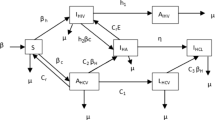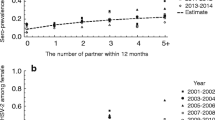Abstract
HIV disease is a major global public health concern since its appearance in the early 1980s. Many mathematical models have been conducted to understand, control, and predict its spread. In this paper we propose a mathematical model with memory effect modelling HIV transmission in a heterosexual population divided into two age classes; young-class (15–24 years old) and grown-class (25 years old and over). The goal of dividing the population according to age is to identify the most vulnerable class to the virus based on their sexual activity and make accurate predictions about HIV transmission. First, we determine the biologically significant space for the study, and we prove the existence of a unique solution. Then we divide the principal model into four sub-models: young-people, grown-people, young-men linked to grown-women, grown-men linked to young-women. The basic reproduction number associated to each sub-model is derived. According to the four sub-models, we have found that, if the basic reproduction number is below unity, then the free disease equilibrium state is locally asymptotically stable. Numerical simulations are provided to validate the theoretical results and discuss the local stability of the endemic equilibrium states of each sub-model. We conclude that incorporating memory conservation gives more realistic results, where reaching a stable state takes higher time. As well, memory effect can play the role of prior knowledge about the disease and experience accumulated over years.









Similar content being viewed by others
References
Blood GAC et al. (2016) Human immunodeficiency virus (HIV). Transfus Med Hemother 43(3):203
Chitnis N, Hyman JM, Cushing JM (2008) Determining important parameters in the spread of malaria through the sensitivity analysis of a mathematical model. Bull Math Biol 70:1272–1296
Cohen MS, Chen YQ, McCauley M et al. (2016) Antiretroviral therapy for the prevention of HIV-1 transmission. N Engl J Med 375(9):830–839
Deeks SG (2006) Antiretroviral treatment of HIV infected adults. BMJ 332(7556):1489
Delavari H, Baleanu D, Sadati J (2012) Stability analysis of Caputo fractional-order nonlinear systems revisited. Nonlinear Dyn 67:2433–2439
Djordjević VD, Jarić J, Fabry B et al. (2003) Fractional derivatives embody essential features of cell rheological behavior. Ann Biomed Eng 31:692–699
Garnett GP, Anderson RM (1993) Factors controlling the spread of HIV in heterosexual communities in develo** countries: patterns of mixing between different age and sexual activity classes. Philos Trans R Soc Lond B Biol Sci 342(1300):137–159
Huo J, Zhao H, Zhu L (2015) The effect of vaccines on backward bifurcation in a fractional order HIV model. Nonlinear Anal Real World Appl 26:289–305
Joint United Nations Programme on HIV/AIDS (UNAIDS) (2021) Global aids update 2021. Tech. rep., UNAIDS, Geneva, Switzerland. https://www.unaids.org/en/resources/documents/2021/global-aids-update
Joint United Nations Programme on HIV/AIDS (UNAIDS) (2022) The global aids update report 2022. UNAIDS website. https://www.unaids.org/en/resources/documents/2022/Global-AIDS-Update-2022
Jones JH (2007) Notes on r0. California: Department of Anthropological Sciences 323:1–19
Kubra KT, Ali R (2023) Modeling and analysis of novel COVID-19 outbreak under fractal-fractional derivative in Caputo sense with power-law: a case study of Pakistan. Modeling Earth Systems and Environment pp 1–18
Kumar P, Erturk VS, Murillo-Arcila M (2021) A complex fractional mathematical modeling for the love story of Layla and Majnun. Chaos Solitons Fractals 150(111):091
Li C, Tao C (2009) On the fractional Adams method. Comput Math Appl 58(8):1573–1588
Marsudi, Hidayat N, Wibowo RBE (2018) Optimal control and sensitivity analysis of HIV model with public health education campaign and antiretroviral therapy. In: AIP Conference Proceedings, AIP Publishing LLC, p 060033
Matignon D (1996) Stability results for fractional differential equations with applications to control processing. Computer Engineering and System Application. Lille, pp 963–968
Omondi E, Mbogo R, Luboobi L (2019) A mathematical modelling study of HIV infection in two heterosexual age groups in Kenya. Infect Dis Modell 4:83–98
Omondi E, Mbogo R, Luboobi L (2022) A mathematical model of HIV transmission between commercial sex workers and injection drug users. Res Math 9(1):2082044
Qian D, Li C, Agarwal RP et al. (2010) Stability analysis of fractional differential system with Riemann-Liouville derivative. Math Comput Model 52(5–6):862–874
Sahu I, Jena SR (2023) Sdiqr mathematical modelling for COVID-19 of Odisha associated with influx of migrants based on Laplace Adomian decomposition technique. Model Earth Syst Environ 1–10
Singh H, Srivastava H, Hammouch Z et al. (2021) Numerical simulation and stability analysis for the fractional-order dynamics of COVID-19. Results Phys 20(103):722
Srivastava H (2000) Fractional differential equations. I podlubny. Appl Mech Rev 53(5):B51–B51
Tuan NH, Mohammadi H, Rezapour S (2020) A mathematical model for COVID-19 transmission by using the Caputo fractional derivative. Chaos Solitons Fractals 140(110):107
Ullah S, Khan MA, Farooq M (2018) A fractional model for the dynamics of TB virus. Chaos Solitons Fractals 116:63–71
Van den Driessche P, Watmough J (2002) Reproduction numbers and sub-threshold endemic equilibria for compartmental models of disease transmission. Math Biosci 180(1–2):29–48
Williams BG (2014) Optimizing control of HIV in Kenya. ar**v preprint ar**v:1407.7801
Author information
Authors and Affiliations
Corresponding author
Ethics declarations
Conflict of interest
The authors have disclosed no competing interests, have made equal contributions to this paper, and have given their approval for its publication.
Additional information
Publisher's Note
Springer Nature remains neutral with regard to jurisdictional claims in published maps and institutional affiliations.
Rights and permissions
Springer Nature or its licensor (e.g. a society or other partner) holds exclusive rights to this article under a publishing agreement with the author(s) or other rightsholder(s); author self-archiving of the accepted manuscript version of this article is solely governed by the terms of such publishing agreement and applicable law.
About this article
Cite this article
Alla Hamou, A., Azroul, E., Bouda, S. et al. Mathematical modeling of HIV transmission in a heterosexual population: incorporating memory conservation. Model. Earth Syst. Environ. 10, 393–416 (2024). https://doi.org/10.1007/s40808-023-01791-6
Received:
Accepted:
Published:
Issue Date:
DOI: https://doi.org/10.1007/s40808-023-01791-6




